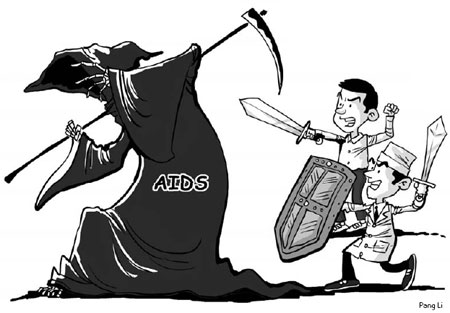
|
OPINION> OP-ED CONTRIBUTORS
 |
|
Heartening progress in war on AIDS
By Michel Sidibé (China Daily)
Updated: 2009-08-12 07:50
More than 1,000 people become infected with HIV in Asia each day. Most of these infections could have been averted if only we had invested in reaching populations at higher risk and their partners -- at a cost of less than half a US dollar per person. We are beginning to see success in some parts of the region, but not enough to break the trajectory of the epidemic. The Commission on AIDS in Asia has recommended that the epidemic in the region be redefined. We must transform the AIDS response so that it works for the people - especially for the marginalized and the voiceless. That means protecting sex workers, men who have sex with men, transgender, people who inject drugs and women. How can we do this? First, decriminalize consensual adult sexual behavior and drug use. Many countries are changing laws that criminalize consensual adult sexual behavior (including prostitution) and drug use, and courts are helping to clarify bad laws. In Indonesia, the Supreme Court ruled that drug users need care, not prison. In Nepal, the highest court has established that transgenders and men who have sex with men have equality under the constitution. And in India, the Delhi High Court has restored dignity to millions by reading down an archaic law that discriminated against men who have sex with men. New Zealand has legalised sex work and reaped the dual benefits of public health and public safety. Australia has demonstrated that law enforcement and public health goals can go hand in hand while dealing with drug use. We can remove punitive laws and policies that block effective responses to AIDS. But the real transformation has to be in the hearts and minds of people. Courts and parliaments can only create an enabling environment. Societies and communities have to change the social norms that allow stigma and discrimination.
 In India, a pregnant woman was recently branded on her forehead as being HIV positive by hospital staff during a routine check-up. This inhumane treatment of the woman triggered protests by the local community and by human rights activists, which led the Gujarat government to launch an investigation. It is this sort of community mobilization that is needed to put an end to such discriminatory acts. Second, address HIV transmission among intimate partners. Bad laws and a discriminatory society have had a severe impact on women. Many women in Asia become infected because their husbands or male partners contracted HIV through drug use or through sex with another man or a sex worker. In India, being monogamous is the only risk factor for an estimated 90 percent of women living with HIV. In 2008, 35 percent of adults living with HIV in Asia were women, and most of them were in steady relationships. Third, invest in evidence-informed HIV prevention, treatment, care and support programs. HIV prevention programs must be scaled up. Political leaders must ensure that existing HIV services are expanded to reach the most vulnerable. This includes starting needle exchange programs and offering oral substation therapy to drug users (great strides in these areas have been made in Bangladesh, China, India, Malaysia and Vietnam), increasing access to antiretroviral drugs, distributing condoms and offering voluntary HIV counseling and testing services to those at higher risk. It is heartening that requests to the Global Fund to Fight AIDS, Tuberculosis and Malaria for such programs have increased substantially in recent years. However, we need $7.5 billion in 2010 to reach country targets, but only 10 percent of this was available in 2007. We must therefore invest wisely and equitably, especially now in the midst of an economic crisis. Fourth, adopt an "AIDS plus Millennium Development Goal (MDG)" approach. Unlike Africa, where the AIDS epidemic can overwhelm development efforts, the Asia and Pacific region can combine development and the AIDS response. Reducing poverty, increasing education and investment in health must become the foundations for sustainable economic growth in the region. This is what I call the "AIDS plus MDG" movement. Recently I read about Nisha, a woman living with HIV in Nepal. She lost her husband in 2004, when there was no access to treatment. Today, she is on antiretroviral therapy. She is staying healthy, has gone back to work and can look after her three children. Her family has come to accept her, and her children go to school, where they are being taught how to protect themselves. Access to treatment has given her an opportunity to fulfill her dreams - this is hope becoming reality. The author is Executive Director of UNAIDS, the Joint United Nations Programme on HIV/AIDS. (China Daily 08/12/2009 page9) |